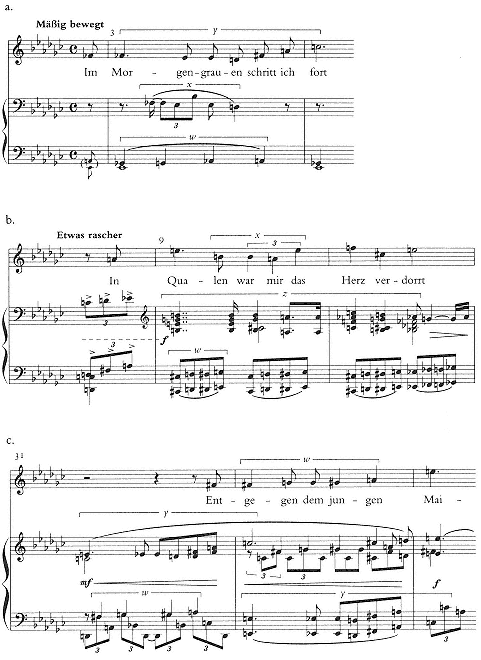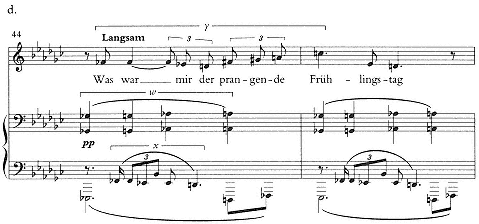Before the Quartet
After spending a year and a half in Berlin, Schoenberg returned to Vienna in the late summer of 1903 and began teaching classes in harmony and counterpoint at the school of Eugenie Schwarzwald and preparing piano arrangements for Universal Edition (Stuckenschmidt 1978, 78). Perhaps because of the move and these other activities, the early fall does not seem to have been a period of compositional productivity, but the late fall and early winter saw a flurry of songwriting and drafting (see table 7). It was at this time too that Schoenberg must have been revising Warnung for inclusion in his op. 3 (as discussed in chapter 4).
There is enormous technical and expressive diversity among the songs of 1903-4, greater than among the songs of the Dehmeljahr, 1899.[1] Perhaps the song that best adumbrates what Schoenberg was to achieve in the First Quartet is Verlassen, op. 6, no. 4, a powerful setting of a text by the naturalist poet Hermann Conradi.[2] The song is especially remarkable for its motivic concentration and for its contrapuntal, linear richness. On the largest scale the song is structured musically as an alternation between two thematic units—one cannot speak here of a single "theme"—which furnish virtually all the compositional material (ex. 8. Ia and b). The piano part begins as a strict one-measure ostinato with two basic motivic
[1] The songs Traumleben, op. 6, no. 1, and Natur, op. 8, no. 1, both from this period, will be treated briefly below in chapter 9 in the context of Neapolitan tonal relationships in the First Chamber Symphony, op. 9.
[2] Conradi (1862-90) was one of the pioneers of naturalism in Berlin in the mid 1880s. He was a contributor to an important volume of poems, Moderne Dichter-Charaktere, ed. Wilhelm Arent and Karl Henckell (Berlin: The Editors, 1885), in which Verlassen first appeared. In an introduction to the collection, Conradi calls for German poetry to abandon the tradition of folklike, sentimental lyrics and to broach topics more relevant to modern sensibilities. His plea is much like that of Karl Bleibtreu, made in the same year (see above, p. 66).
| ||||||||||||||||||||
components: rising chromatic steps unfolded in even quarter notes (w) and a figure containing a syncopated triplet (x). Above, the voice adds a third motivic idea (y), which shares or doubles the initial

The harmonic language is also, of course, affected by a texture so densely motivic that, as Webern said of op. 7, "everything is thematic" (Webern 1912; translated in Rauchhaupt 1971, 16). The opening is oriented around




Example 8.1
Verlassen, op. 6, no. 4.

Example 8.1
continued
The intensity of the motivic working, the emphasis on invertible counterpoint at thematic returns, and the large role played by vagrant chords all mark Verlassen as a significant precursor of the D-Minor Quartet. A still more immediate precedent is another string quartet in D minor, which was to remain incomplete. This prior D-minor quartet, perhaps begun as early as 1901, but worked on most intensively in 1903-4,[3] is first alluded to by Egon Wellesz, who notes that in the summer of 1903 Schoenberg was working on "a string quartet which may be regarded as the predecessor of the D minor, Op. 7" (Wellesz 1925, 18). This must be a reference to the movement in D minor and a scherzo in F major, which are sketched intensively alongside op. 7 in the early portions of the so-called Sketchbook I, first used in the spring of 1904.[4] In addition to these sketches, there survives a fully scored draft of eighty measures of the opening movement, evidently begun as a fair copy (printed in SW A20: 219-25).
This torso provides important evidence of Schoenberg's compositional devel-
[3] Sketches for it appear in a pocket sketchbook used intermittently by Schoenberg between 1901 and 1908. See the discussion by Schmidt in SW B20: 279-84, who suggests (279) a starting date of 1901 for the fragmentary D-minor quartet because sketches for it are to be found among some for the Brettl-Lieder. Stylistically, however, the quartet fragment would seem to belong more to 1903.
[4] Schoenberg's sketchbooks from the period 1904-16, now in the archives of the Arnold Schoenberg Institute in Los Angeles, were first mentioned by Wellesz (1925, 19-20). They were described in greater detail in 1959 by Josef Rufer (who called them Sketchbooks I, II, and III, a practice I shall follow in this study), and in 1972 by Jan Maegaard (Rufer 1962, 126; Maegaard 1972, 1: 20-21). The most definitive and complete account, including detailed bibliographic descriptions, is that prepared by Schmidt for SW. See SW B3: 21-23 (Sketchbook I); B11/II: 1-5 (Sketchbook II); and B11/II: 6-7, 82-90 (Sketchbook III).

Example 8.2
Comparison of Fugue Subjects.
opment in instrumental forms between Pelleas und Melisande and the quartet that became op. 7. It is a slow, highly chromatic double fugue in which two subjects are presented independently and then combined.[5] Although no material was taken over directly from the earlier D-minor effort into op. 7, Wellesz was right to consider one a "predecessor" of the other. Schoenberg did incorporate a slow, chromatic fugue into op. 7—not at the opening, but as the transition to the second group of the first movement. In fact, the initial fugue subject of op. 7 bears certain striking similarities to the subject of the earlier D-minor fugue (cf. ex. 8.2a and motive b of ex. 8.3). Both are in duple dme and begin with a syncopated figure; both contain a pair of prominent downward leaps (minor sixths in the earlier fugue, diminished fifths in op. 7), followed by an upward semitone resolution.
The D-minor fugue subject not only anticipates the op. 7 transition; it also looks back to the most renowned nineteenth-century precedent for a fugal opening in a string quartet, Beethoven's Quartet in

[5] The fugue is analyzed in some detail, with transcriptions, by Schmidt in SW B20: 290-303. It is also discussed in Hattesen 1990, 167-90.
his op. 7.[6] The Beethoven quartet was obviously very much in his mind's ear as he worked toward, and on, op. 7 in the years 1903-4.
The first two bars of the earlier D-minor subject also hint at Schoenberg's characteristic interest in symmetrically arrayed tonal relationships. The dominant is decorated by the upper neighbor,






It is not clear either why Schoenberg abandoned work on the earlier D-minor quartet or what larger shape that work would ultimately have taken. Perhaps the massive double fugue came to seem too cerebral an opening for a quartet, even one by so committed a contrapuntalist as Schoenberg. In any case, in the spring of 1904, Schoenberg began work on the quartet that was to become op. 7 and was to occupy his energies on and off for a year and a half. In later years, Schoenberg would view this composition as representing a significant new direction in his musical development. He explained in 1949:
Thereafter [after Verklärte Nacht and Pelleas] I abandoned program-music and turned in the direction that was much more my own than all the preceding. It was the First String Quartet, Op. 7, in which I combined all the achievements of my time (including my own) such as: the construction of extremely large forms; greatly expanded melodies based on a richly moving harmony and new chord progressions; and a contrapuntal technique that solved problems offered by superimposed, individual parts which moved freely in more remote regions of a tonality and met frequently in vagrant harmonies.
RAUCHHAUPT 1971, 36
Although these remarks, as well as the D-Minor Quartet itself, would seem to signal a firm return to "absolute" instrumental music, Schoenberg would also allude frequently in later years to a "secret program" for op. 7 (see Bailey 1984, 130; Schmidt 1986, 230). When editing the quartet for SW, Schmidt discovered the outline of such a program on the inside cover of Sketchbook I; there can be
[6] See Schoenberg's notes for the first recordings of his own string quartets, prepared in 1936 (Steiner 1978, 132-33). Schoenberg also mentions Beethoven's quartet in typed notes for a lecture given at the University of Southern California in the 1930s.
little doubt that it refers to op. 7.[7] This program constitutes neither a poem nor a story line, as in Verklärte Nacht and Pelleas, but rather a succession of feelings or moods, which, as both Schmidt and Mark Benson have suggested (Benson 1987), can be matched with some precision to portions of op. 7, especially in the scherzo, for which the first sketches in Sketchbook I are marked "Neues Leben fühiend," a phrase that also appears as part of the program outline.